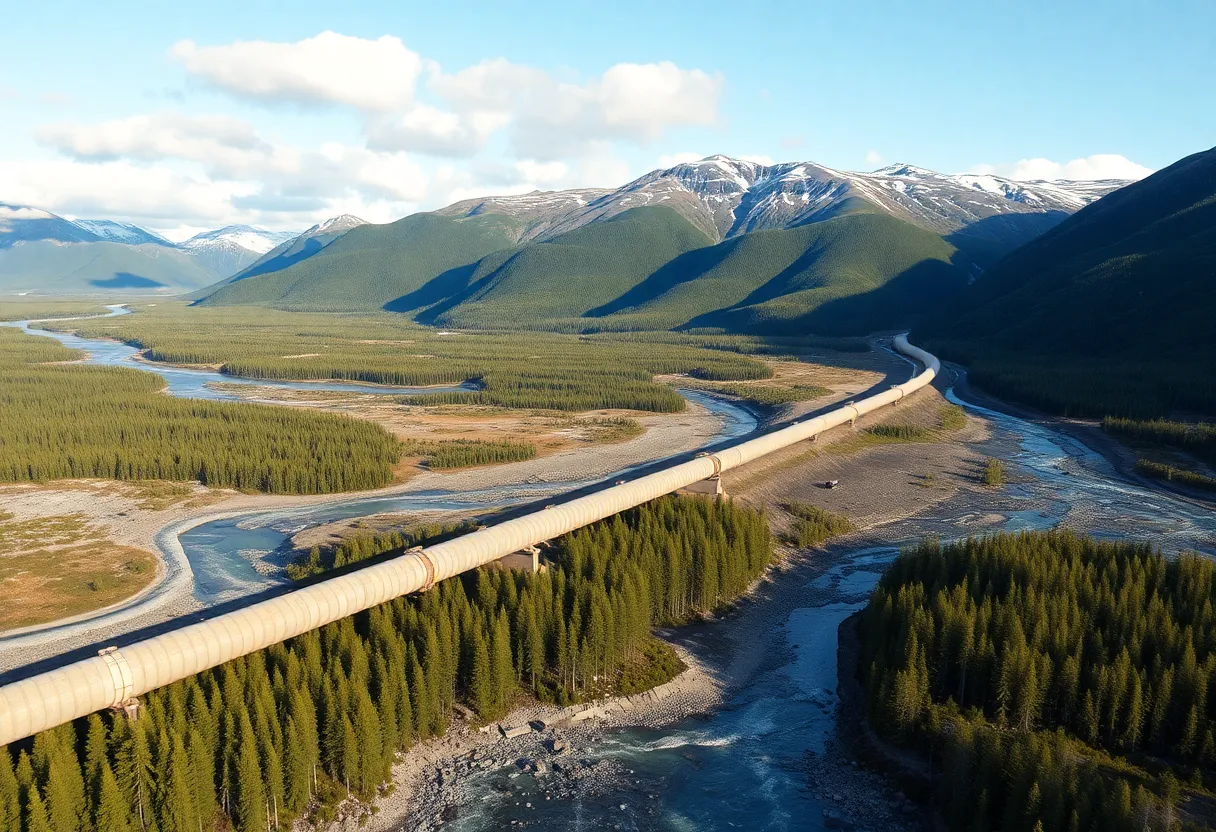News Summary
The Trump administration is pushing for an ambitious liquefied natural gas (LNG) project in Alaska, projected to cost over $40 billion. The project aims to construct an 800-mile pipeline from the North Slope to Cook Inlet for gas exports to Asia. While the administration is optimistic, investor skepticism looms over the project due to concerns about commercial backing and a lengthy timeline. Support comes from the Department of Defense, but environmental opposition exists. With plans to secure investments soon, the project stands as a significant step towards energy security and international trade relations.
Trump Administration’s Bold Vision for Alaska LNG Project
The Trump administration is feeling pretty optimistic about a hefty liquefied natural gas (LNG) project in Alaska that’s expected to cost over $40 billion. They believe that despite some bumps in the road—like investor skepticism—the project is on the right track. Since day one of his presidency, Trump has been waving the flag for Alaska LNG, declaring it a national priority.
A Long Journey for Alaska’s Pipeline
Alaska has been itching to get an 800-mile pipeline up and running, traveling from the North Slope, which is located above the Arctic Circle, right down to Cook Inlet. The goal is to transport gas that will be cooled and exported to friendly nations in Asia. The excitement here is real, but it’s important to note that this project has been in planning stages for years.
Encouraging Asian Investment
Trump has been chatting about this project with Japan and South Korea, hinting that financial backing from these countries could lead to smoother trade agreements with the U.S. These countries are facing pressure to invest, especially to keep tariffs from climbing high. Energy Secretary Chris Wright shared that securing buyers for the gas would simplify the financing process. There’s a significant push for these nations to lower their trade deficits with the U.S. by purchasing more American energy.
Investor Concerns and Skepticism
But let’s not ignore the elephant in the room. Energy analysts have raised eyebrows, suggesting that the project lacks solid commercial backing and logic. Even though the project aims to serve the domestic gas demands in Alaska due to dwindling supplies in Cook Inlet, potential investors are sounding alarms regarding the timeline and logistical challenges. Initial deliveries could potentially kick-off in 2028 or 2029, with exports to Asia not arriving until the early 2030s. This timeline is making some Asian investors a bit uneasy.
Support from the Department of Defense
In an interesting twist, the Department of Defense is all aboard, saying they would support the project as well by securing an off-take agreement for military bases in Alaska. This could provide a nice boost to the project’s credibility. If the project hits its targets, imagine being able to deliver gas to Japan in just eight days, compared to the 24 days it currently takes for gas dispatched from the U.S. Gulf Coast!
Navigating Troubling Waters
On a more geographical note, the project is carved out to avoid some of the contested waters in the South China Sea commonly used by LNG exports from the Middle East, which is a strategic move in today’s economic climate.
Developers Looking Ahead
The lead developer, Glenfarne Group, is planning to nail down a final investment decision soon—potentially in the next six to twelve months—for a section of the pipeline connecting North Slope to Anchorage. There’s significant hope here for progress, especially with recent visits from Trump administration officials to Prudhoe Bay. They have been meeting with Asian dignitaries itching for an opportunity to invest in Alaska LNG.
Environmental Concerns and Opposition
However, amidst all the enthusiasm, conservation and tribal groups are sounding the alarm, claiming that the project could seriously harm Alaska’s naturally beautiful environment. Critics are raising red flags about the estimated costs, which some believe could be underestimated, leading to concerns over federal subsidies.
A Commitment to Resource Development
The administration is also looking to lift some regulatory restrictions from the last administration on drilling in the National Petroleum Reserve-Alaska to foster more oil and gas activity. While this has warmed the hearts of many oil workers, it’s left environmental advocates feeling the heat in the opposite direction.
The Bigger Picture
Regardless of the challenges, many see the Alaska LNG project as a fantastic opportunity to tap into Alaska’s vast natural resource pool. It symbolizes a larger movement toward achieving energy security and maintaining balanced trade relations with Asian nations. With high-level involvement and a commitment to resource development, it seems this is a story just beginning to unfold.
Deeper Dive: News & Info About This Topic
- CNBC: Trump Administration’s Confidence in Alaska LNG Investment
- Wikipedia: Liquefied Natural Gas
- Anchorage Daily News: Trump Officials’ Commitment to Alaska Pipeline
- Google Search: Alaska LNG Project
- Frontiersman: Trump Officials Boosting Alaska LNG Project
- Encyclopedia Britannica: Natural Gas
- OilPrice: Trump Administration’s Plans for Alaska Oil Drilling
- Google News: Trump Alaska Energy
- Forbes: Trump’s Tariff Pressure and US-Asia Energy Cooperation
- Google Scholar: Alaska Energy Projects

Author: STAFF HERE AUGUSTA WRITER
The AUGUSTA STAFF WRITER represents the experienced team at HEREAugusta.com, your go-to source for actionable local news and information in Augusta, Richmond County, and beyond. Specializing in "news you can use," we cover essential topics like product reviews for personal and business needs, local business directories, politics, real estate trends, neighborhood insights, and state news affecting the area—with deep expertise drawn from years of dedicated reporting and strong community input, including local press releases and business updates. We deliver top reporting on high-value events such as Arts in the Heart Festival, Westobou Festival, and Masters Week. Our coverage extends to key organizations like the Augusta Metro Chamber of Commerce and Greater Augusta Arts Council, plus leading businesses in manufacturing and healthcare that power the local economy such as Textron Specialized Vehicles, Cardinal Health, and Nutrien. As part of the broader HERE network, including HEREAtlanta.com and HERESavannah.com, we provide comprehensive, credible insights into Georgia's dynamic landscape.





